How to Format a Spilled Array in Excel
Use formula conditional formatting to handle overflow arrays in Excel
Direct formatting of overflow arrays in Excel can cause problems, especially when the data shape or size changes. Formula-based conditional formatting rules allow automatic formatting when data parameters change. Adding a dollar sign ($) before a column reference applies a rule to all rows in the data.
In Excel, you can apply direct formatting to the values or background of a cell to make the spreadsheet easier to read. However, when an Excel formula returns a set of values (called overflow arrays), applying direct formatting will cause problems if the size or shape of the data changes.
Suppose you have this spreadsheet with spillover results from the PIVOTBY formula that shows the number of viewers per sport in each region over the past four years.
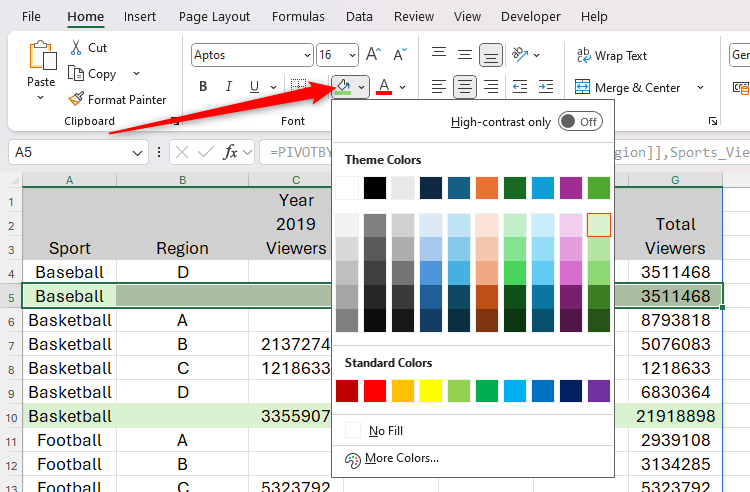
Since the PIVOTBY function does not contain parameters that allow you to format the results, it is difficult to distinguish between title rows, data rows, subtotal rows, and total rows.
At this point, you might want to apply direct formatting through the Fonts group on the Start tab of the ribbon to intuitively distinguish different types of rows in your data.
However, if you later modify the parameters in the PIVOTBY formula, or the results are enlarged or reduced due to changes in the original data, the direct formatting you applied will not be adjusted accordingly. This is because direct formatting in Excel is associated with cells, not with the data they contain. See the screenshot below where the data has been reduced, but the direct formatting is still applied to the same row, which can cause confusion.
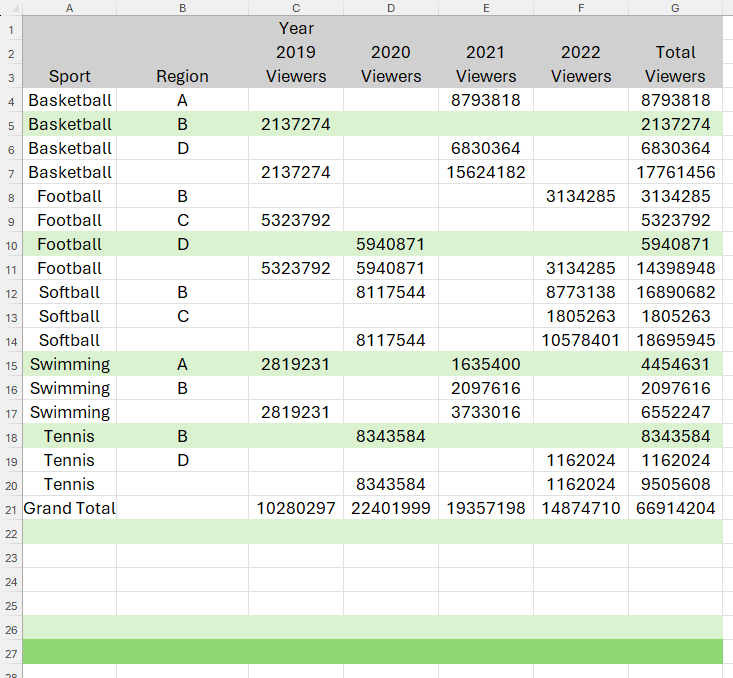
Instead, you should use conditional formatting, which allows you to format them based on the values of the cells and rows.

Select all the data (and some extra rows at the bottom to allow vertical growth), and on the Start tab of the ribbon, click Conditional Format > Manage Rules.

Next, in the Conditional Format Rule Manager dialog box, click New Rule.
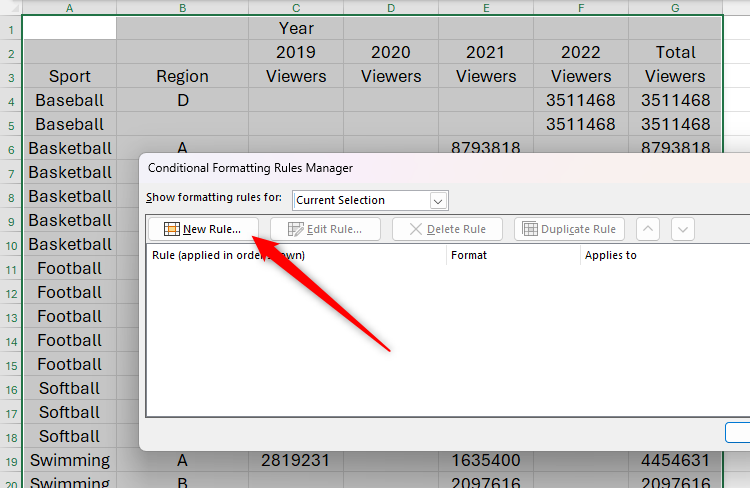
For every rule you will create to format overflow arrays, you need to use formulas. Therefore, in the Select Rule Type area of the New Format Rule dialog box, select the last option Use formula to determine which cell to format.
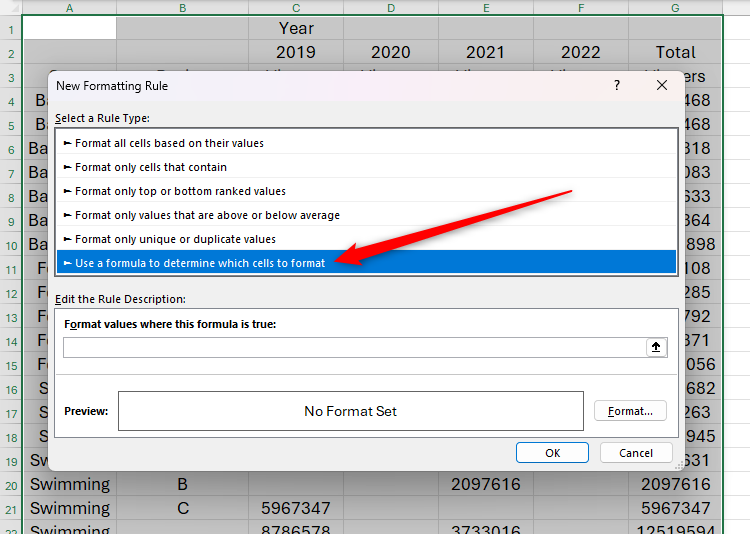
The first rule you want to create is related to the title line. Specifically, you want these cells to be on a gray background.
To do this, take a moment to determine what makes the title row different from the other rows in the table. In this example, the title row is the only row in column G that does not contain numbers. So, in the Formula field, type:
<code>=ISTEXT($G1)</code>
Since the ISTEXT function treats empty cells and cells containing text as text values, the conditional formatting rules will consider cells G1 to G3 to contain text, while the rest of the cells in the G column contain numeric values.
Importantly, adding a dollar sign ($) before a column reference repairs the conditional formatting to this column while allowing Excel to apply rules to the rest of the rows.
Finally, because you initially selected the data from columns A to G, the conditional format will be applied to the entire row that satisfies the condition.
Now, click Format to select the format of the title row. In this case, you want them to be gray. Then, click OK in the Format Cell and Edit Format Rules dialog box.
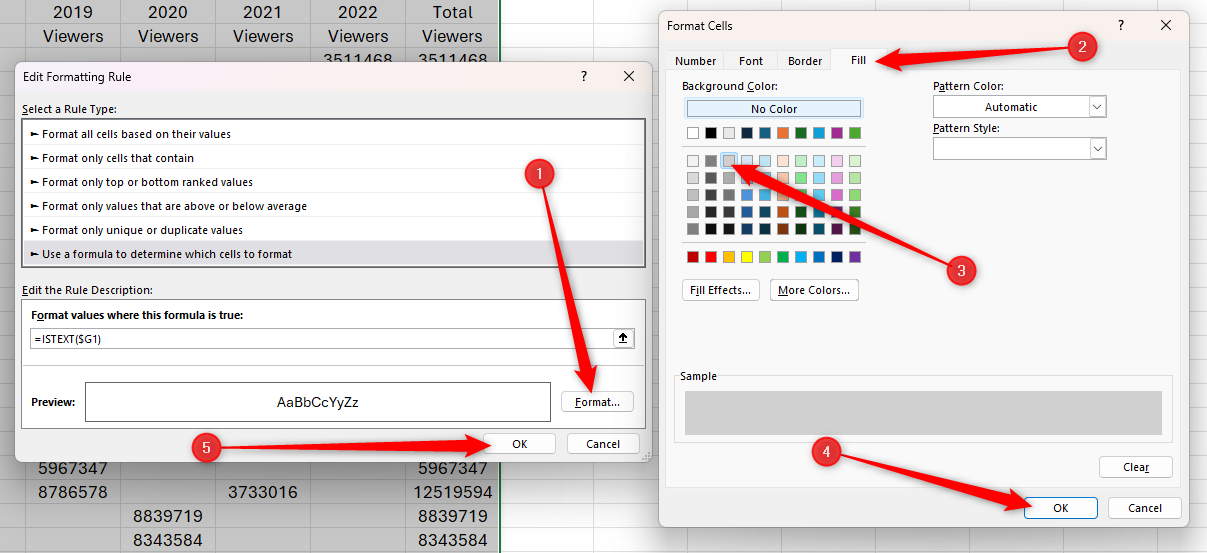
When you click Apply in the Conditional Format Rule Manager dialog box, you will see that only the G columns contain empty cells or text (in other words, the title row) are filled with gray.
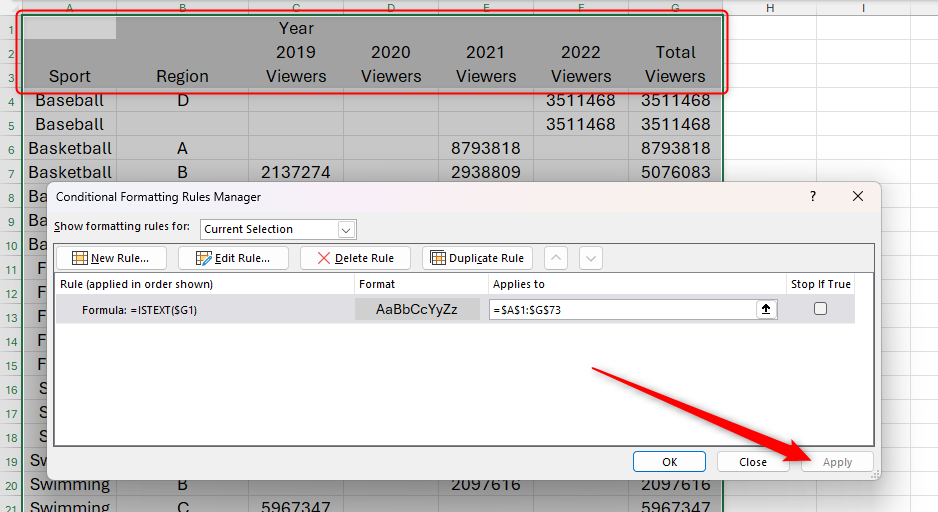
Next, you want to format the subtotal rows so they are filled with light green.
Take a closer look at the data again and see which conditions you can use to apply the format to these rows only. In this example, the subtotal row contains text in column A, but nothing in column B. Additionally, since the total row also meets these conditions, you need to exclude any cells in column A that contain the word "total".
With the Conditional Format Rule Manager dialog box still open, click New Rule and select the option that allows you to format cells using formulas. This time, in the formula field, type:
<code>=AND($A1"",$B1="",$A1"Grand Total")</code>
in:
- The AND function allows you to specify multiple conditions in parentheses.
- $A1" ""Tell Excel to find cells that do not contain () empty cells ("") in column A.
- $B1="" Tell Excel to find cells containing (=) empty cells ("") in column B, and
- $A1"Grand Total" tells Excel to exclude () any cells in column A that contain the text "Grand Total".
As with the previous rules, remember to insert the $ symbol before the column reference to allow Excel to apply the same rule to all selected rows.
Now, click Format to select a light green fill color, and after closing the Format Cells and Edit Format Rules dialog boxes, click Apply to see that the subtotal rows are filled with light green.
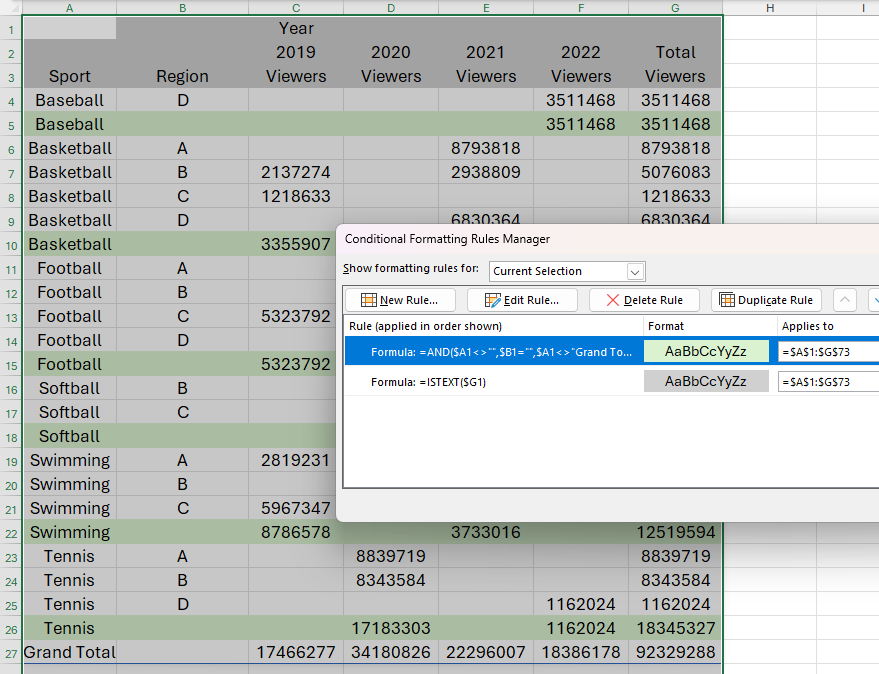
Finally, you want the cells in the total row to be filled with darker green.
Since the total row is the only row in column A that contains the word "total", this is the condition you can use for conditional formatting. In the Conditional Format Rule Manager dialog box, click New Rule, and then select the last option in the Select Rule Type list. Now, in the Formula field, type:
<code>=$A1="Grand Total"</code>
Next, click Format and select the bold green fill color you want to apply to the cell that matches this condition. Now when you close the Format Cells and Edit Format Rules dialogs and click Apply in the Conditional Format Rule Manager dialog, you will see that the total rows are in this format.
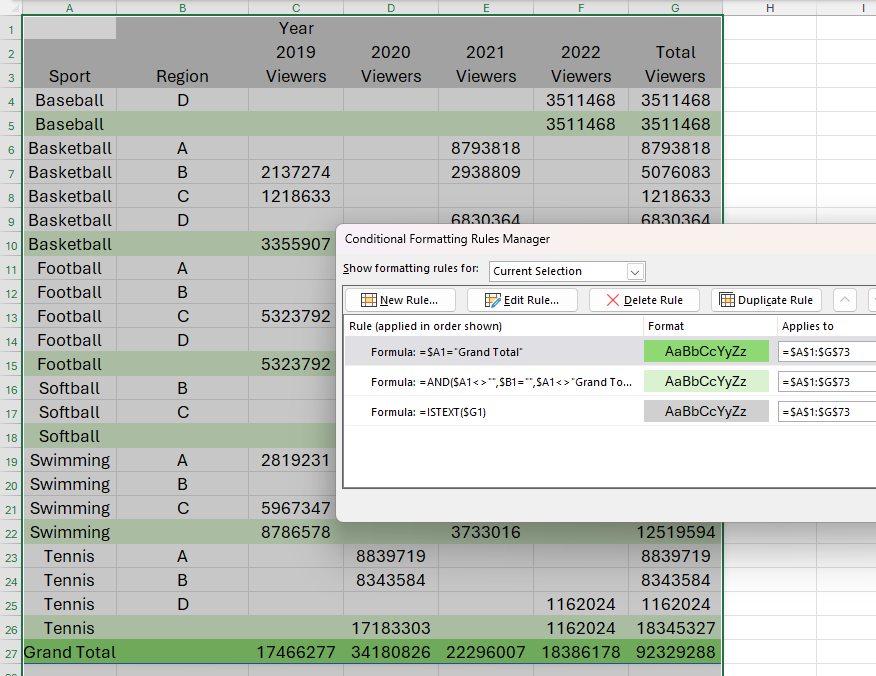
Now that you have applied all the rules, click Close in the Conditional Format Rule Manager dialog box. Then, adjust some data in the original table and see if the overflow results and their formats are updated accordingly.
In this example, even if I delete 12 rows from the original data table, the overflowing PIVOTBY results are still formatted correctly, the title behavior is gray, the subtotal behavior is light green, and the total behavior is bold green.

If you need to change the rules you have created and applied, simply select any cell in the data and click Conditional Format > Manage Rules to restart Conditional Format Rules Manager. Then, double-click the rule to change its conditions.
The above is the detailed content of How to Format a Spilled Array in Excel. For more information, please follow other related articles on the PHP Chinese website!

Hot AI Tools

Undresser.AI Undress
AI-powered app for creating realistic nude photos

AI Clothes Remover
Online AI tool for removing clothes from photos.

Undress AI Tool
Undress images for free

Clothoff.io
AI clothes remover

AI Hentai Generator
Generate AI Hentai for free.

Hot Article

Hot Tools

Notepad++7.3.1
Easy-to-use and free code editor

SublimeText3 Chinese version
Chinese version, very easy to use

Zend Studio 13.0.1
Powerful PHP integrated development environment

Dreamweaver CS6
Visual web development tools

SublimeText3 Mac version
God-level code editing software (SublimeText3)

Hot Topics
 1378
1378
 52
52
 5 Things You Can Do in Excel for the Web Today That You Couldn't 12 Months Ago
Mar 22, 2025 am 03:03 AM
5 Things You Can Do in Excel for the Web Today That You Couldn't 12 Months Ago
Mar 22, 2025 am 03:03 AM
Excel web version features enhancements to improve efficiency! While Excel desktop version is more powerful, the web version has also been significantly improved over the past year. This article will focus on five key improvements: Easily insert rows and columns: In Excel web, just hover over the row or column header and click the " " sign that appears to insert a new row or column. There is no need to use the confusing right-click menu "insert" function anymore. This method is faster, and newly inserted rows or columns inherit the format of adjacent cells. Export as CSV files: Excel now supports exporting worksheets as CSV files for easy data transfer and compatibility with other software. Click "File" > "Export"
 How to Use LAMBDA in Excel to Create Your Own Functions
Mar 21, 2025 am 03:08 AM
How to Use LAMBDA in Excel to Create Your Own Functions
Mar 21, 2025 am 03:08 AM
Excel's LAMBDA Functions: An easy guide to creating custom functions Before Excel introduced the LAMBDA function, creating a custom function requires VBA or macro. Now, with LAMBDA, you can easily implement it using the familiar Excel syntax. This guide will guide you step by step how to use the LAMBDA function. It is recommended that you read the parts of this guide in order, first understand the grammar and simple examples, and then learn practical applications. The LAMBDA function is available for Microsoft 365 (Windows and Mac), Excel 2024 (Windows and Mac), and Excel for the web. E
 If You Don't Use Excel's Hidden Camera Tool, You're Missing a Trick
Mar 25, 2025 am 02:48 AM
If You Don't Use Excel's Hidden Camera Tool, You're Missing a Trick
Mar 25, 2025 am 02:48 AM
Quick Links Why Use the Camera Tool?
 How to Create a Timeline Filter in Excel
Apr 03, 2025 am 03:51 AM
How to Create a Timeline Filter in Excel
Apr 03, 2025 am 03:51 AM
In Excel, using the timeline filter can display data by time period more efficiently, which is more convenient than using the filter button. The Timeline is a dynamic filtering option that allows you to quickly display data for a single date, month, quarter, or year. Step 1: Convert data to pivot table First, convert the original Excel data into a pivot table. Select any cell in the data table (formatted or not) and click PivotTable on the Insert tab of the ribbon. Related: How to Create Pivot Tables in Microsoft Excel Don't be intimidated by the pivot table! We will teach you basic skills that you can master in minutes. Related Articles In the dialog box, make sure the entire data range is selected (
 Use the PERCENTOF Function to Simplify Percentage Calculations in Excel
Mar 27, 2025 am 03:03 AM
Use the PERCENTOF Function to Simplify Percentage Calculations in Excel
Mar 27, 2025 am 03:03 AM
Excel's PERCENTOF function: Easily calculate the proportion of data subsets Excel's PERCENTOF function can quickly calculate the proportion of data subsets in the entire data set, avoiding the hassle of creating complex formulas. PERCENTOF function syntax The PERCENTOF function has two parameters: =PERCENTOF(a,b) in: a (required) is a subset of data that forms part of the entire data set; b (required) is the entire dataset. In other words, the PERCENTOF function calculates the percentage of the subset a to the total dataset b. Calculate the proportion of individual values using PERCENTOF The easiest way to use the PERCENTOF function is to calculate the single
 You Need to Know What the Hash Sign Does in Excel Formulas
Apr 08, 2025 am 12:55 AM
You Need to Know What the Hash Sign Does in Excel Formulas
Apr 08, 2025 am 12:55 AM
Excel Overflow Range Operator (#) enables formulas to be automatically adjusted to accommodate changes in overflow range size. This feature is only available for Microsoft 365 Excel for Windows or Mac. Common functions such as UNIQUE, COUNTIF, and SORTBY can be used in conjunction with overflow range operators to generate dynamic sortable lists. The pound sign (#) in the Excel formula is also called the overflow range operator, which instructs the program to consider all results in the overflow range. Therefore, even if the overflow range increases or decreases, the formula containing # will automatically reflect this change. How to list and sort unique values in Microsoft Excel
 How to Format a Spilled Array in Excel
Apr 10, 2025 pm 12:01 PM
How to Format a Spilled Array in Excel
Apr 10, 2025 pm 12:01 PM
Use formula conditional formatting to handle overflow arrays in Excel Direct formatting of overflow arrays in Excel can cause problems, especially when the data shape or size changes. Formula-based conditional formatting rules allow automatic formatting to be adjusted when data parameters change. Adding a dollar sign ($) before a column reference applies a rule to all rows in the data. In Excel, you can apply direct formatting to the values or background of a cell to make the spreadsheet easier to read. However, when an Excel formula returns a set of values (called overflow arrays), applying direct formatting will cause problems if the size or shape of the data changes. Suppose you have this spreadsheet with overflow results from the PIVOTBY formula,





